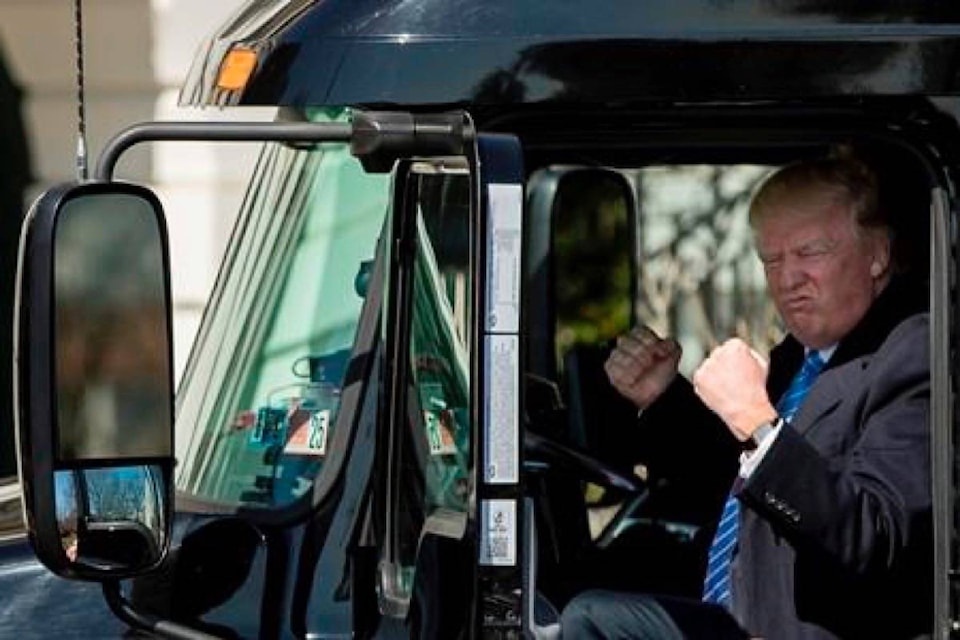WASHINGTON — President Donald Trump is putting the brakes on attempts to address dangerous safety problems from speeding tractor-trailers to sleepy railroad engineers as part of his quest to roll back regulations across the government, according to a review by The Associated Press of Transportation Department rule-making activities.
A dozen transportation safety rules under development or already adopted have been repealed, withdrawn, delayed, or put on the back burner since Trump took office last year. There have been no significant new safety rules approved during that time.
The sidelined rules would have, among other things, required states to conduct annual inspections of commercial bus operators, railroads to operate trains with at least two crew members and automakers to equip future cars and light trucks with vehicle-to-vehicle communications to prevent collisions.
In most cases, the rules are opposed by powerful industries. The political appointees running the agencies that write the rules often come from the industries they regulate.
Many of the rules were prompted by tragic events.
“These rules have been written in blood,” said John Risch, the International Association of Sheet Metal, Air, Rail and Transportation Workers’ legislative director. “But we’re in a new era now of little-to-no new regulations no matter how beneficial they might be.”
Trump has sought to eliminate regulations throughout the government, viewing them as unnecessary restraints on economic growth. He has ordered that two regulations be identified for elimination for every significant new one issued.
DOT says it can reduce regulations without undermining safety and questions the effectiveness of some proposed regulations. It declined repeated AP requests since November for an on-the-record interview with a top official to discuss safety regulations. Instead, the department provided a brief statement from James Owens, DOT’s deputy general counsel, saying that new administrations typically take a “fresh look” at regulations, including those that are the most costly.
“We will not finalize a rule simply because it has advanced through preliminary steps,” Owens said. “Even if a rule is ‘one step away,’ if that rule is not justifiable because it harms safety and imposes unnecessarily high economic costs, for example, that rule will not advance.”
One rule, proposed by DOT in 2016, would require new heavy trucks to have software that electronically limits their speeds. The government didn’t designate a top speed but said it had studied 60, 65 and 68 mph.
The White House moved the proposal from its list of active rulemakings to its long-term agenda after Trump took office. DOT says the rule isn’t dead, but the department has limited resources and higher priorities.
The rule would save as many as 498 lives per year and produce a net cost savings to society of $475 million to nearly $5 billion annually depending on the top speed the government picked, DOT estimated two years ago.
Rick Watts of Morristown, Tennessee, lost his wife, two young step-daughters and mother-in-law when the driver of an 18-ton tractor-trailer travelling about 80 mph failed to brake for cars in a slow-rolling construction zone backup near Chattanooga in 2015. The truck bashed into eight vehicles, killing six and injuring four others.
“If you’re going 80 and you’re knocked down to 60, that’s going to lower the impact,” Watts said. “It just baffles me that they’re killing so many people every year.”
The American Trucking Associations, an industry trade group, initially supported the rule, but now claims credit for stalling it. The group says it would create dangerous speed differentials between cars and trucks.
Trucking officials met with Transportation Secretary Elaine Chao within hours after she took office, according to Chris Spear, the trade group’s president. Trump welcomed trucking executives to the White House by climbing behind the wheel of a Mack semi parked on the South Lawn in March.
“Your story is now being told to the highest levels of government,” Spear told his organization’s members in October.
Last summer, DOT withdrew a rule the government was in the early stages of writing to require train engineers and truck and bus drivers to be screened for sleep apnea, a condition that pauses breathing and prevents restful sleep.
The National Transportation Safety Board has cited sleep apnea as a cause of 13 rail and highway accidents it has investigated, including three commuter train crashes in New York and New Jersey since 2013. Investigators say federal regulators share the blame because they haven’t required medical screening for sleep disorders.
The Transportation Department said current safety programs either address the problem or it will be addressed in another rule to reduce fatigue in the railroad industry. But the fatigue rule is years overdue with no timetable for completion.
The agency has a number of political appointees with strong ties to the industries they regulate. Deputy Transportation Secretary Jeff Rosen, who heads DOT’s task force that evaluates regulations for repeal or modification, is an attorney who previously represented General Motors and an airline industry trade group. Daniel Elwell, the acting administrator at the Federal Aviation Administration, is a former airline lobbyist. Cathy Gautreaux, deputy administrator at the Federal Motor Carrier Safety Administration, which regulates the trucking industry, was executive director of a Louisiana trucking advocacy group for 29 years. Ron Batory, head the Federal Railroad Administration, was president of Conrail, a service provider for the CSX and Norfolk Southern freight railroads. Howard Elliott, head of the Pipeline and Hazardous Materials Safety Administration, is a former CSX executive. His agency sets safety rules for rail transport of hazardous goods.
Neil Eisner, who was the DOT assistant general counsel in charge of overseeing the issuing of regulations for more than three decades, said industry’s influence on government regulations in general “is probably more powerful than it has ever been.”
The department says having industry insiders in leadership positions provides deep practical experience in how the transportation industry works.
